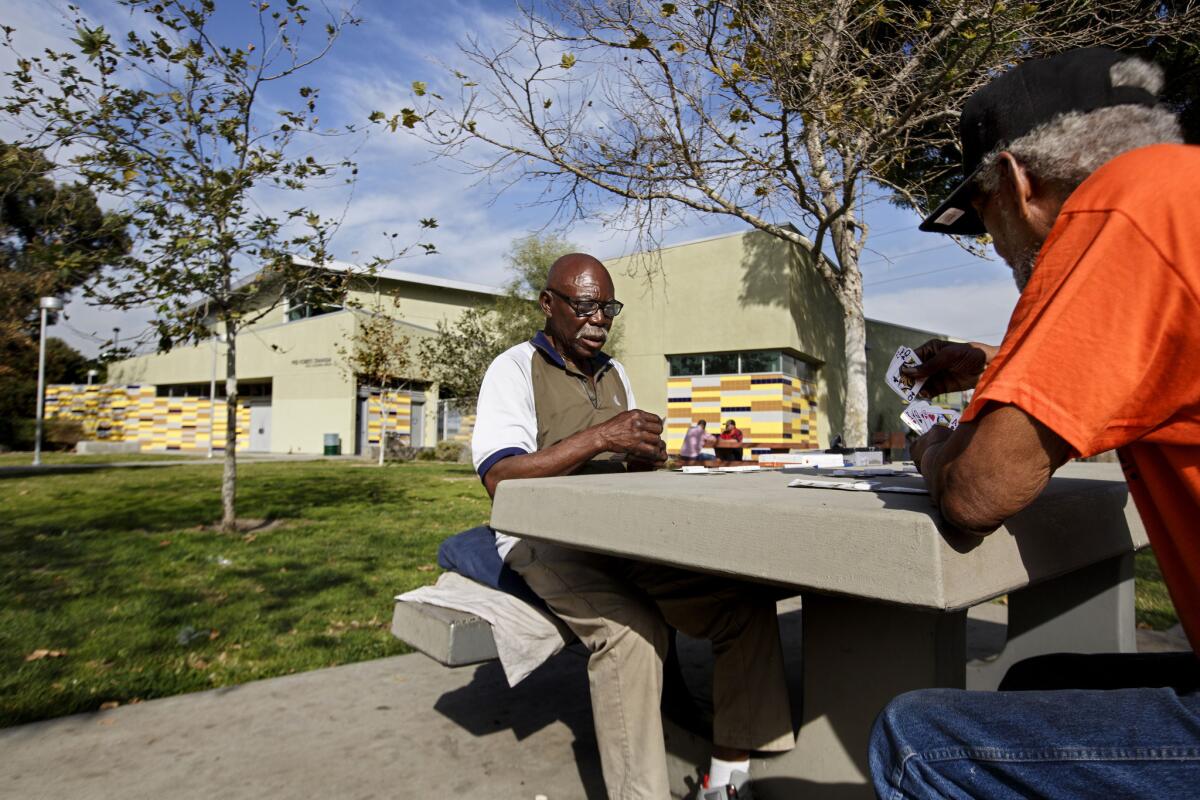County officials look to parcel tax to help L.A.’s park-poor communities

Mack Henry Conley, left, and Michael Jewell play pinochle in January at Fred Roberts Recreation Center in South Los Angeles, an area that is among the most park-poor parts of L.A. County.
- Share via
In Malibu, sandwiched between a sprawling national recreation area and a 13-mile beachfront, an abundance of parkland is one of the community’s many charms. The city has on average 13 acres of parks for each 1,000 residents.
But miles away in the San Gabriel Valley communities of El Monte and South El Monte, the picture is far bleaker: El Monte has less than half an acre of parkland per 1,000 residents and South El Monte has just slightly more.
“The very little parks we do have, access is terrible and they’re not safe,” said David Diaz Avelar, a resident of South El Monte and coordinator at Day One, a nonprofit public health organization. He pointed to problems with lighting, sidewalks and criminal activity at the parks. Diaz Avelar believes the lack of parks fuels high rates of childhood obesity in the communities.
In a report issued Wednesday, Los Angeles County officials sought to highlight such disparities to help build support for a parcel tax that officials are considering for the November ballot.
The average countywide was 3.3 acres of parkland per 1,000 residents. The study found 51% of county residents live more than half a mile from the nearest park. And in the areas where they do have parks nearby, the facilities are often rundown or difficult to access because of freeways and other barriers. The most park-poor areas were concentrated in central and South Los Angeles, southeast county areas and parts of the San Fernando and San Gabriel Valleys.
Norma E. Garcia, deputy director of Los Angeles County’s Department of Parks and Recreation, said park money took a hit throughout the county during the recession.
“Cities have been struggling to keep law enforcement, to keep basic services available,” she said. “We’ve seen less funding for park and recreation systems.”
County officials are hoping to use the assessment as ammunition in a second attempt at raising property taxes to pay for new parks and improvements at existing facilities.
A proposed $23 parcel tax for park projects failed narrowly in 2014. The measure, which was intended to replace expiring parks taxes passed in 1992 and 1996, needed a two-thirds majority to pass but got 63%. Opponents criticized the lack of a defined project list and said poor communities would not get a fair share of the funding.
After the defeat, county supervisors commissioned a more exhaustive study of park needs. The process included an inventory of more than 3,000 parks throughout the county and dozens of community meetings to develop a list of the highest-priority projects.
County park officials are recommending that the supervisors pursue a parcel tax of either three or five cents per developed square foot. A three-cent tax would raise $191 million annually and cost the average homeowner about $45 a year. The five-cent option would bring in $309 million a year and cost homeowners an average of $75 a year.
The 2014 measure would have generated an estimated $54 million a year via a flat tax of $23 per parcel. The previous park measures, one of which expired in 2015 and the other set to expire in 2019, brought in about $80 million a year.
This time around, instead of the old “divide by five” method of divvying money among the five county supervisorial districts, the funding would be allocated based on need and would be guided by a list of priority projects that came out of the community meetings, said Jane Beesley, district administrator of the Los Angeles County Regional Park and Open Space District.
The final list of priority projects has not been released, but county officials said the needs assessed countywide came to a total of $21.5 billion. That includes proposed new parks as well as repairs to existing facilities and adding new infrastructure such as aquatic facilities, fields and walking trails at existing parks.
Diaz Avelar, who rallied local youths to advocate for funding for a proposed public multiuse sports complex at El Monte’s Mountain View High School, said he was encouraged by the effort county officials put into getting community feedback.
Elsa Fraire, 21, a UCLA student who has lived in unincorporated Lennox all her life, was more skeptical. Her community has vacant lots, but only one small park for a population of more than 23,000.
“If we’re paying the tax money, why aren’t we seeing it here?” Fraire said. If another parks tax is passed, she said, “We’d like communities that really need it to be prioritized.”
County supervisors are set to discuss the findings and the potential tax measure at their weekly meeting Tuesday.
Twitter: @sewella
Join the conversation on Facebook >>
ALSO
Former San Francisco police lieutenant charged with impeding rape investigation
L.A.’s water wasters will soon face heavier fines and audits
‘Jurassic Park’ actor sentenced to 6 years in prison for lewd act with 13-year-old girl
More to Read
Sign up for Essential California
The most important California stories and recommendations in your inbox every morning.
You may occasionally receive promotional content from the Los Angeles Times.











